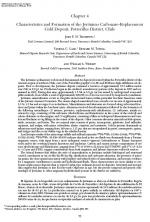Добрый день, Коллеги. Важное сообщение, просьба принять участие. Музей Ферсмана ищет помощь для реставрационных работ в помещении. Подробности по ссылке
Characteristics and formation of the Jerónimo carbonate-replacement gold deposit, Potrerillos District, Chile
The Jerónimo sedimentary rock-hosted disseminated Au deposit is located within the Potrerillos district of the Atacama region of northern Chile, east of the Potrerillos porphyry Cu-Mo and El Hueso high-sulfidation Au deposits. Prior to development, the Jerónimo deposit contained a resource of approximately 16.5 million metric tons (Mt) at 6.0 g/t Au. Production began in the oxidized, nonrefractory portion of the deposit in 1997 and terminated in 2002. During that time, approximately 1.5 Mt at 6.8 g/t Au was mined by underground room-and-pillar methods, from which a total of approximately 220,000 oz of Au was recovered by heap-leach cyanidation.
Jerónimo mineralization occurs as irregular strata-bound lenses within particular bioclastic limestone units of the Jurassic Asientos Formation. The manto-shaped mineralized zone extends over an area of approximately 2.0 by 1.3 km and averages 6 m in thickness. Mineralization and alteration are focused along subvertical fractures and joints within the bioclastic units. Alteration involved decarbonatization followed by the formation of the following assemblages: (1) intense, pervasive, replacement-style silicification; (2) carbonate, mainly restricted to vugs, consisting of Mn carbonate (rhodochrosite and kutnohorite) in the center of the orebody and calcite-dolomite on the margins; and (3) argillization, consisting of illite as widespread disseminations and vein-lets and kaolinite as vug fillings in the center of the deposit. Other common alteration minerals include apatite, rutile, monazite, and barite. The ore mineral suite consists of pyrite, arsenopyrite, sphalerite, lead sulfosalts, orpiment, and realgar, with minor coloradoite, altaite, cinnabar, and cassiterite. Gold is present dominantly as submicron-sized grains, ranging from 140 nm to 1.13 µm, that are encapsulated in pyrite, arsenopyrite, quartz, and realgar and also occur within vugs in the silicified matrix.
Lead isotope results of the main-stage sulfide and sulfosalt minerals (206Pb/204Pb: 18.564–18.644; 207Pb/204Pb: 15.592–15.662; 208Pb/204Pb: 38.536–38.638) indicate that lead in the ore fluids was dominantly from a Tertiary magmatic source, with input from a more radiogenic source—igneous Carboniferous to Triassic basement rocks and/or the overlying Jurassic limestone and sandstone. Carbon and oxygen isotope compositions of ore zone rhodochrosite and kutnohorite, ranging from δ18O of 16.65 to 22.52 per mil (VSMOW) and δ13C of –2.84 to –1.3 per mil (PDB), suggest contributions from both magmatic and Jurassic limestone wall-rock sources.
The critical features that define the style of mineralization at Jerónimo include lithological and structural control, enrichment in Au-As-Mn-Zn-Pb-Ag-Hg, silicification and carbonate alteration, the presence of native Au grains, the close spatial association with porphyry and related styles of mineralization, and isotopic evidence for a magmatic contribution to metals and hydrothermal fluids. These characteristics are more similar to carbonate-replacement deposits than to typical Carlin-type sediment-hosted Au deposits. Structural and isotopic data suggest that Jerónimo is late Eocene-early Oligocene in age, but the precise temporal and genetic relationships of Jerónimo to other magmatic-hydrothermal systems in the district are unknown.




